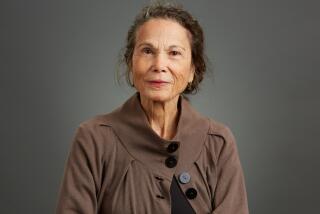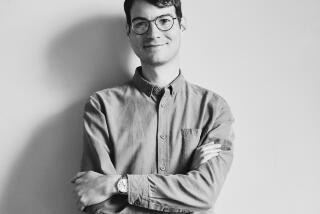Review: Women’s paths diverge in Elena Ferrante’s epic ‘Those Who Leave’
I first encountered Elena Ferrante’s fierce, singular voice in her second novel, “The Days of Abandonment,” an unrelenting exploration of a woman whose husband has left her. In her newest novel, “Those Who Leave and Those Who Stay,” the third of her quartet of “Neapolitan novels,” we come up for air.
Centered on the friendship between Elena Greco, the protagonist, and Lila Cerullo, her childhood friend, “Those Who Leave” seamlessly braids those same urgent domestic concerns with the volatile political landscape of Italy in the late ‘60s and early ‘70s.
------------
FOR THE RECORD
An earlier version of this post said that Elena Ferrante’s novel “Those Who Leave and Those Who Stay” was the last of her trilogy of “Neapolitan novels.” It’s the third of a quartet.
------------
The women’s lives have diverged when the book begins in 2010. Elena, who has become a novelist and is at work on a new book, remembers a walk taken five years previously in their old neighborhood in Naples.
“Too many bad things, and some terrible, had happened over the years, and to regain our old intimacy we would have to speak our secret thoughts, but I didn’t have the strength to find the words…,” says Elena. She goes on to do just that: She finds the strength to speak both women’s secret thoughts.
In “Those Who Leave,” most everything has already happened. It is a book of evidence, the effects of the past told, never shown, and yet it remains compelling, visceral and immediate. The past’s touchstones and many characters who have appeared in the previous volumes are alluded to often, but the book stands alone, gallantly becoming for the reader what it is for Elena Greco — an exercise in remembering.
After a dip into the present, Elena goes back to the late ‘60s and her first public reading where the reader meets her long-ago crush, Nino, and Pietro, her Florentine fiancé, who is from a politically active family with a “good” name. Her social ascension widens the physical and psychic gap from her traumatized childhood self, but that distance is too easily diminished. When, upon the publication of Elena’s first novel, a professor criticizes her in public, she falters; when she’s praised, her ego soars. And so Ferrante hits precisely on the place where confidence and fragility meet.
During this time Elena stumbles on a political meeting that begins to grow in her an unshakable consciousness. But the reader gets the sense that her concerns are more personal and artistic than political. Despite her novelist’s heart, she writes about the appalling working conditions of the factory where Lila now works, cribbing directly from Lila’s experience with sexual harassment. Finally she feels worthy, accepted by her husband’s politicized community. And yet when a bourgeois revolutionary tells Elena, “You wanted to write novels, I created a novel with real people, with blood, in reality,” she is wounded and horrified that her work is not seen as participatory, with the potential to effect change.
“Those Who Leave” is as expansive and broad as it is intimate. It brings to mind Marco Tullio Giordana’s Italian epic, “The Best of Youth,” a six-hour made-for-television series that weaves the personal and political lives of two brothers over four generations. For Elena, the true intersection of social change and personal transformation happens after she marries Pietro and becomes pregnant.
“I ignored her and tried to think of myself,” Elena writes of her first child as she tries to work. Then another daughter arrives and the subsequent depictions of the conflict between art and parenting are remarkable.
For Elena the friction is not merely about time or money but in the ways that desire of all sorts waxes and wanes. One wrong word, from someone she considers important, about her new work and into the drawer it goes. Instead she turns all of her attention to her children, not for their benefit — they are well taken care of without her constant care — but to protect against her own artistic vulnerabilities.
Her struggle to write is in part what drives the narrative: Will she write again, and how will she, and why will she, and whatever will it be? We must know.
At its root, “Those Who Leave” is a riveting examination of power. Who has it? Is it the artist? Is it the radical? Is it the person born to wealth? Is it the husband? Is it the past? Writing is where Elena’s strength lies. Only when she sees the clichés in political rhetoric and finds her subject in feminism — a shift from “what it meant to make your own head masculine so that it would be accepted by the culture of men” — does she experience the power of sexual and artistic possibility.
If the novel has a shortcoming, it’s with Lila. Elena writes of her friend that “she was like the full moon when it crouches behind a forest and the branches scribble on its face.” But in this installment she is more a branch, brittle and subject to snapping in the wind. Her power and beauty and intelligence are only shadows, even while she remains the novel’s conscience, angrily delivering its most telling line. On the phone when Elena is extolling (falsely) the magic of motherhood, Lila responds, “Each of us narrates our life as it suits us.”
Ferrante writes with the kind of power saved for weather systems with female names, sparing no one, and “Those Who Stay” is a tour de force. I don’t want to read anything else.
Gilmore is the author, most recently, of “The Mothers.”
Those Who Leave and Those Who Stay
Elena Ferrante, translated from the Italian by Ann Goldstein
Europa: 400 pp., $18 paper
More to Read
Sign up for our Book Club newsletter
Get the latest news, events and more from the Los Angeles Times Book Club, and help us get L.A. reading and talking.
You may occasionally receive promotional content from the Los Angeles Times.






